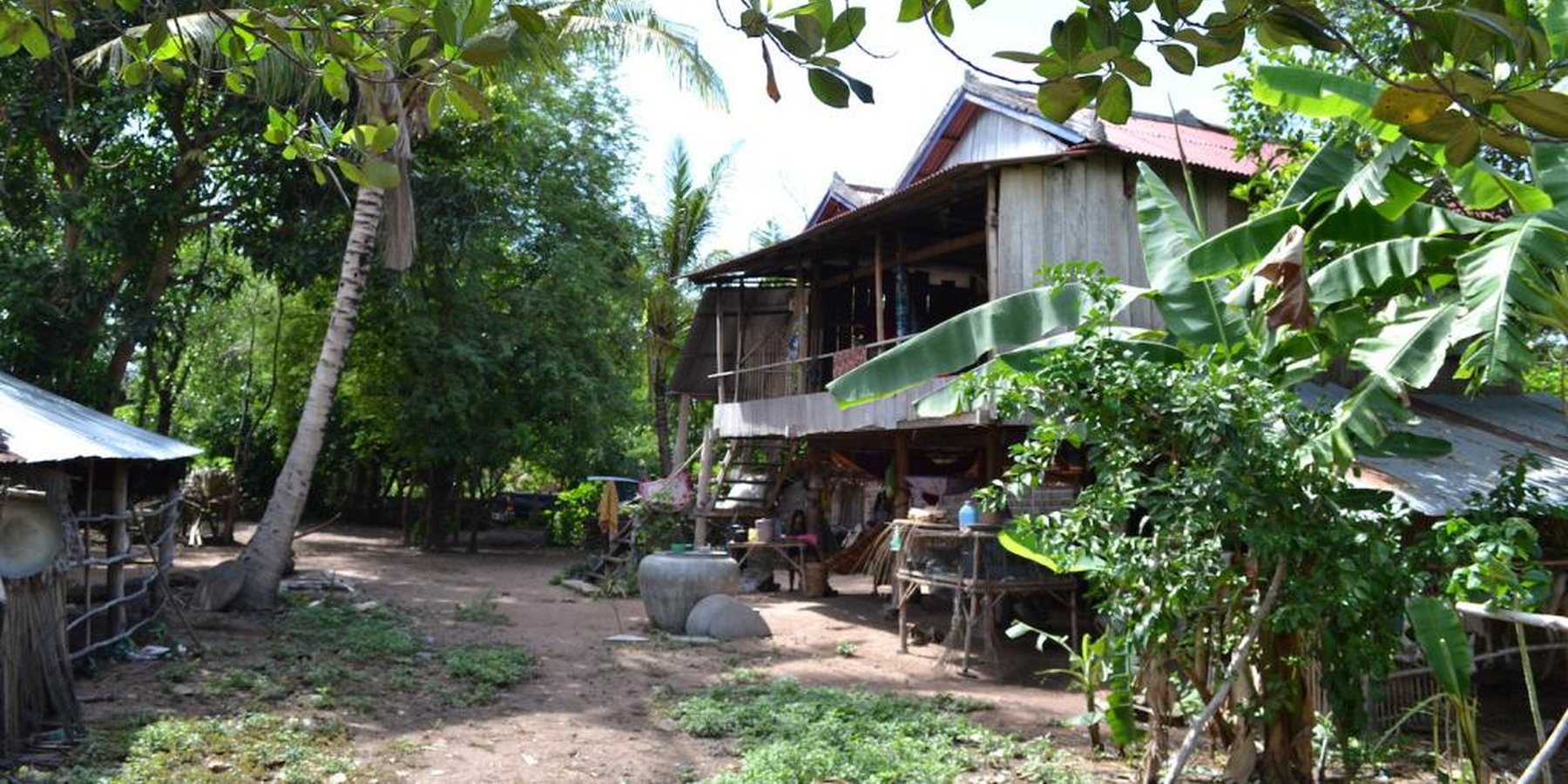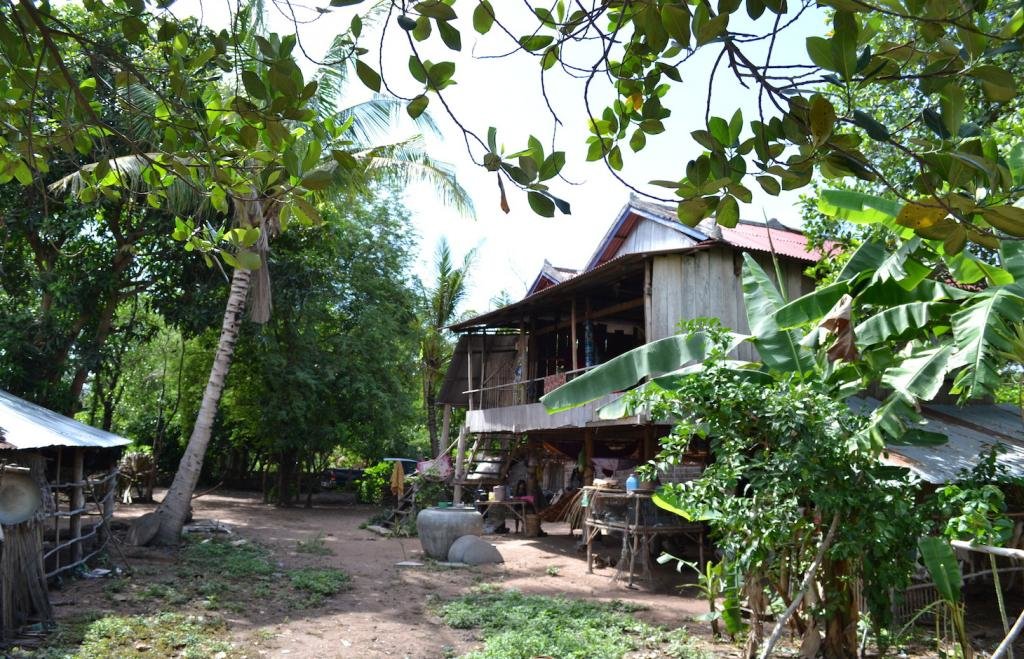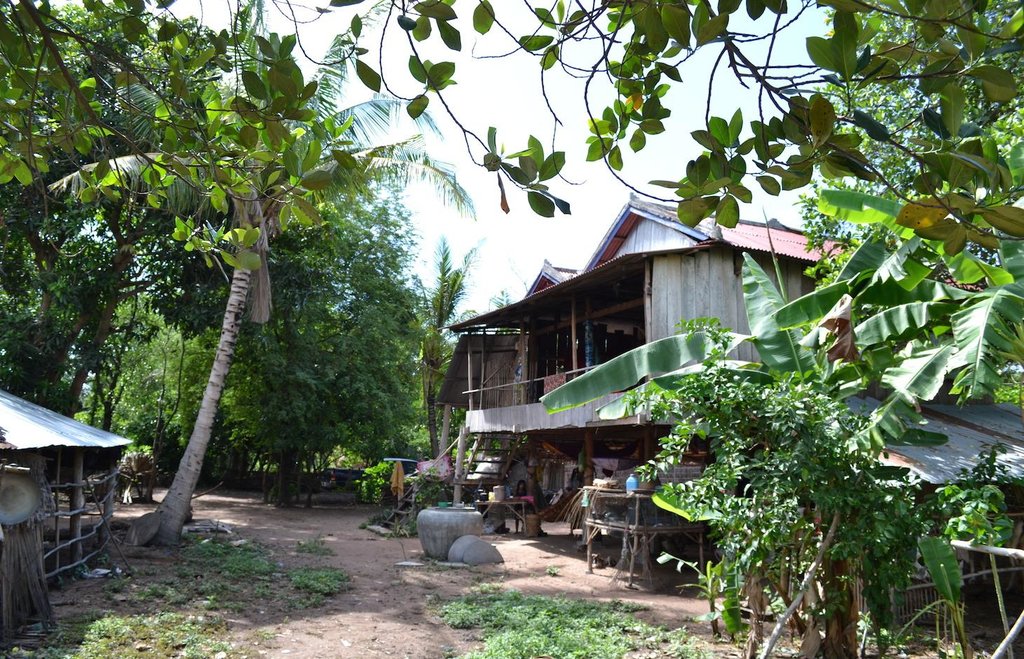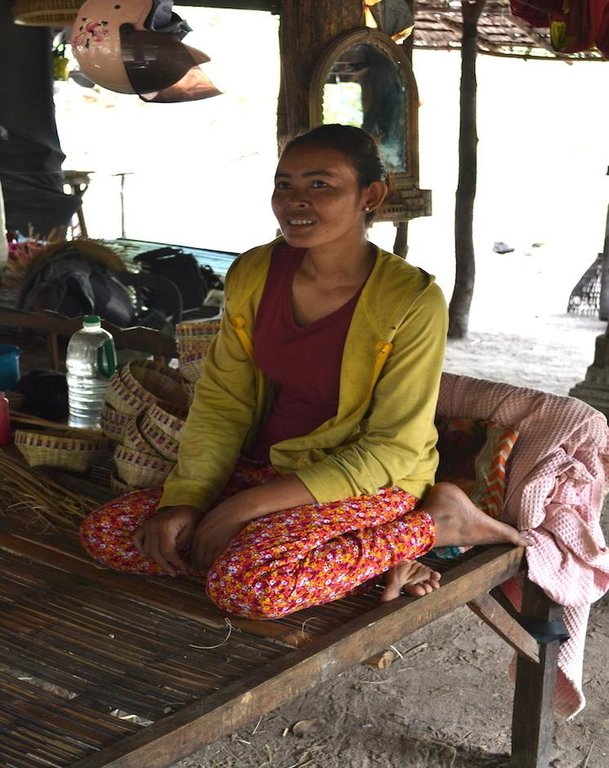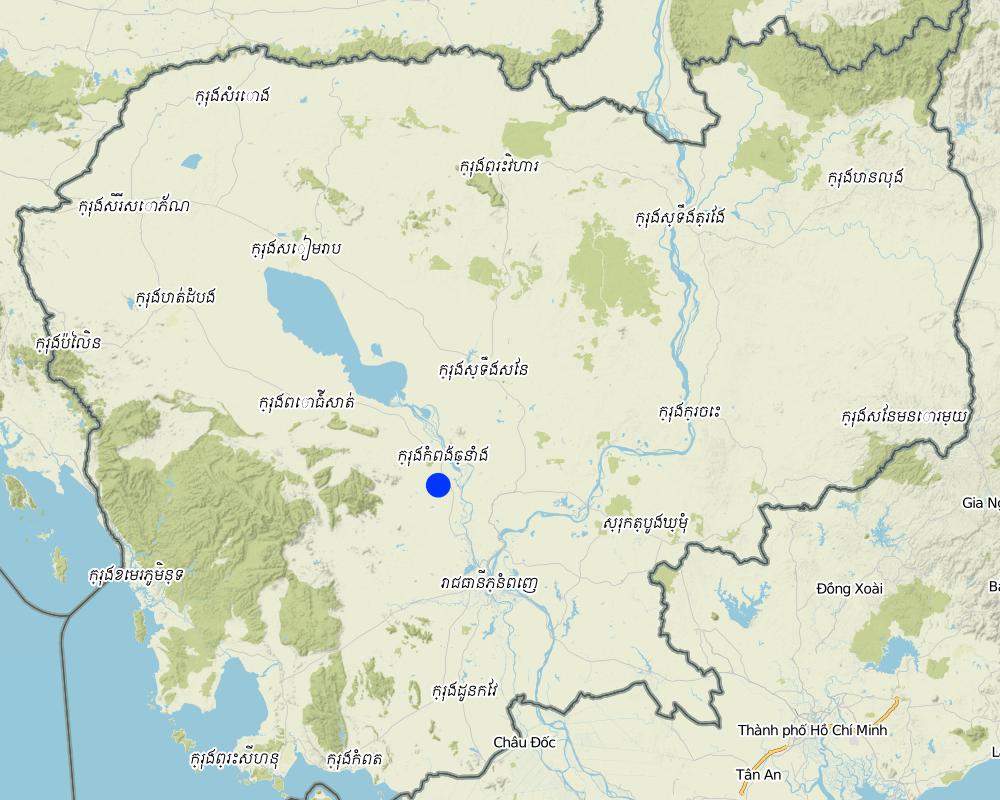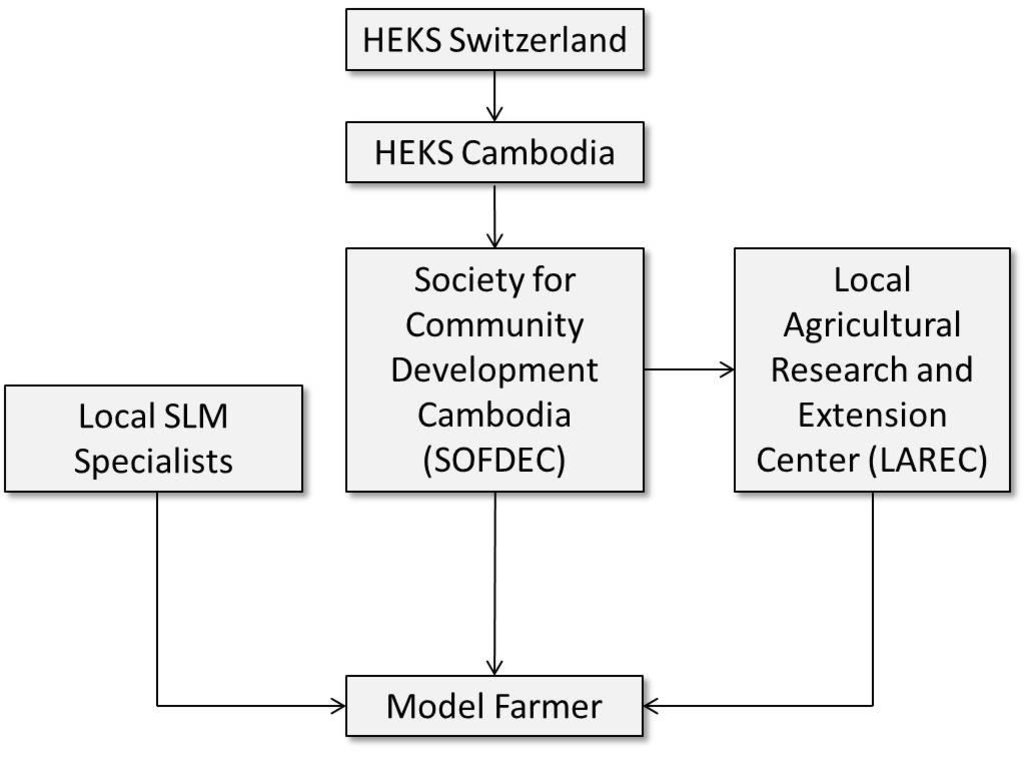Model farmer [Cambodia]
- Creación:
- Actualización:
- Compilador: Christoph Kaufmann
- Editor: –
- Revisor: David Streiff
approaches_2498 - Cambodia
Visualizar secciones
Expandir todo Colapsar todos1. Información general
1.2 Detalles de contacto de las personas de referencia e instituciones involucradas en la evaluación y la documentación del Enfoque
Especialista MST:
Especialista MST:
Say Mesa
Society for Community Development in Cambodia
Cambodia
Especialista MST:
Bin Sreytouch
Society for Community Development in Cambodia
Cambodia
Especialista MST:
Khun Lean Hak
SOFDEC/LAREC
Nombre de la(s) institución(es) que facilitaron la documentación/ evaluación del Enfoque si fuera relevante)
Local Agricultural Research and Extension Centre (LAREC) - CambodiaNombre de la(s) institución(es) que facilitaron la documentación/ evaluación del Enfoque si fuera relevante)
Society for Community Development in Cambodia (SOFDEC) - CambodiaNombre de la(s) institución(es) que facilitaron la documentación/ evaluación del Enfoque si fuera relevante)
CDE Centre for Development and Environment (CDE Centre for Development and Environment) - Suiza1.3 Condiciones referidas al uso de datos documentados mediante WOCAT
¿Cuándo se compilaron los datos (en el campo)?
25/06/2014
El compilador y la/s persona(s) de referencia claves aceptan las condiciones acerca del uso de los datos documentados mediante WOCAT :
Sí
1.4 Referencia/s al/los Cuestionario(s) de Tecnologías MST
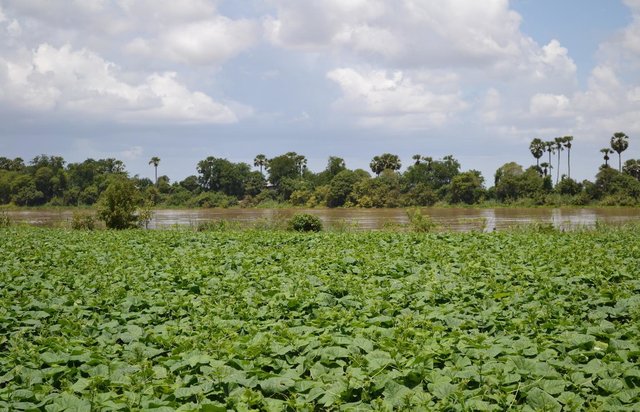
Mulching with water hyacinth (Eichhornia crassipes) after the … [Cambodia]
Water hyacinth (Eichhornia crassipes) is collected during the monsoon floods, attached to poles on the flooded fields, chopped when the water recedes and used as mulch to plant different crops.
- Compilador: Christoph Kaufmann
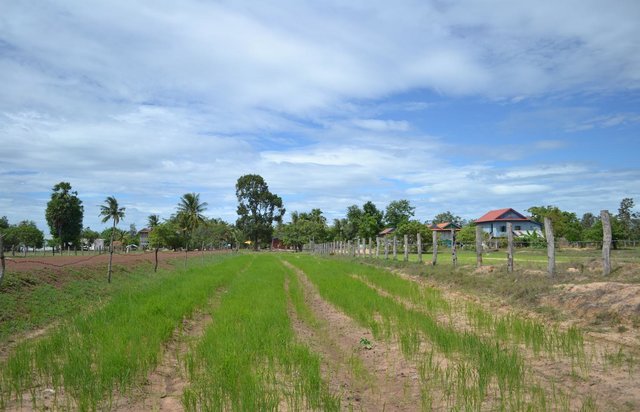
Adapted System of Rice Intensification (SRI) principles in … [Cambodia]
Some points of the System of Rice Intensification (SRI) technology, like the row transplanting of young seedlings and the use of compost are adapted and applied in Kampong Chhnang.
- Compilador: Christoph Kaufmann
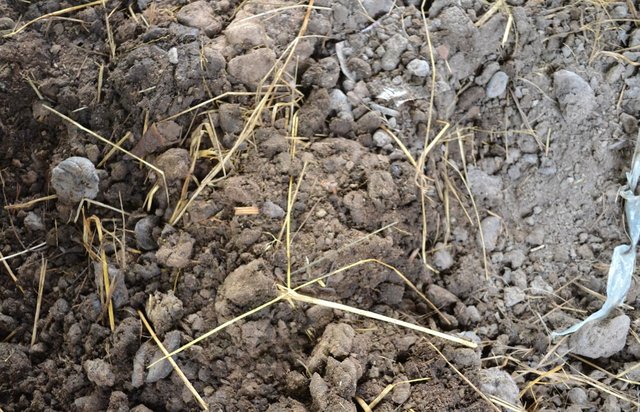
Compost application on rice fields [Cambodia]
Manure, leaves and rice straw are gathered in a compost house and the produced compost is applied twice a year to the rice field.
- Compilador: Christoph Kaufmann
2. Descripción del Enfoque MST
2.1 Breve descripción del Enfoque
Model farms were introduced by a NGO in order to spread knowledge about SLM (compost, System of Rice Intensification SRI, and other technologies) in the project area.
2.2 Descripción detallada del Enfoque MST
Descripción detallada del Enfoque MST:
Aims / objectives: Model farms were introduced to Kampong Chhnang Province in order to spread knowledge about SLM Technologies.
Methods: The Approach focuses on various areas of farming, and the model farms are clustered into 4 groups:
1. Compost and System of Rice Intensification focus on rice productivity and soil improvement.
2. SLT (Seasonal Long Training) – growing techniques for different crops, seedling germination, care taking, harvesting, etc.
3. INTEREST – focus on different crops which are mixed, crop rotation (rice-watermelon-corn, e.g.), mulching, cover cropping.
4. Cow raising model farmers – focus on fodder production, vaccination, supplementary feed for the cows, stable construction.
In this case study, the model farmer applies the System of Rice Intensification (SRI) and compost (cluster 1).
Stages of implementation: Becoming a model farmer consists of different steps. First, different land users who dispose of the required inputs (certain amount of land, labour availability, motivation for innovation) are invited to a training organized by a local NGO. After the training, the model farmers are chosen amongst the participating land users. These newly elected model farmers get further training from the NGO. While implementing the selected Technologies (in this case SRI and compost), the model farmers are subsidized and monitored by the NGO.
Role of stakeholders: The role of the stakeholders is both active and passive. While they are invited to the initial training provided by the local NGO (passive), the land users decide - once they're selected as model farmers - by themselves which Technologies they want to apply on their fields (active).
Other important information: The benefits of this Approach are manifold. Firstly, it helps spreading knowledge about sustainable land management in the project area. In the case of Cambodia this is especially important since much of the agricultural knowledge was lost during the Khmer Rouge regime (1975-1979). Furthermore, the soils in the project area are sandy and show a low fertility. Therefore for example compost making can have a positive long term impact on both the natural and the human wellbeing. Secondly, model farmers can have a positive impact on local institutions. It is for example possible for the farmers to give a report to local authorities where they state what the villagers need most. Furthermore, model farmers can become members of NGOs or local authorities, or monitor other farmers in their activities.
The main disadvantage of the Approach is the problem of sustainability. Model farmers are in close cooperation with the local NGO, and if the NGO stops the coaching, it is not ensured that the implemented Technologies will continue. This is illustrated by many abandoned compost houses in the area. Also, the interviewed model famer expressed that since she became a model farmer, there is more work to do. This can be detrimental in an environment where a high migration rate decreases the available labour force. Last but not least the decision about which Technologies are to be applied on the given model farms are mainly taken by the SLM specialists working for the local NGO. If land users were more involved in the decision-making process, this might have a positive long term impact on the farmers motivation to continue applying the chosen Technologies independently (sustainability).
2.3 Fotos del Enfoque
2.5 País/ región/ lugares donde el Enfoque fue aplicado
País:
Cambodia
Región/ Estado/ Provincia:
Kampong Chhnang
Especifique más el lugar :
Rolear Pha-er
Comentarios:
For one model farmer, there are approximately 5 other farmers who copy the technologies
Map
×2.6 Fechas de inicio y conclusión del Enfoque
Indique año del inicio:
2006
2.7 Tipo de Enfoque
- proyecto/ basado en un programa
2.8 Propósitos/ objetivos principales del Enfoque
The Approach focused on SLM only
On one hand, land users learn about new technologies (e.g. compost, SRI) which have a positive impact on the yields, the soil fertility and in consequence on the income. On the other hand, model farmers are enabled to show these technologies to other land users (knowledge sharing) so these technologies can be spread in the area. One way to share the knowledge are farmer field days where other land users visit the model farms.
The SLM Approach addressed the following problems: Lack of technical knowledge, low agricultural production, low soil fertility.
2.9 Condiciones que facilitan o impiden la implementación de la/s Tecnología/s aplicadas bajo el Enfoque
marco de trabajo legal (tenencia de tierra, derechos de uso de tierra y agua)
- facilitan
The current situation of land use rights and ownership is rather complicated since there are different perceptions coexisting. Therefore, no concluding statement about the influence of this situation on the implementation of model farms can be made.
- impiden
The process of formalizing land use rights in Cambodia is slow. No relationship between this Approach and land use rights.
conocimiento de MST, acceso a apoyo técnico
- impiden
Other farmers did not have technical knowledge about the technologies
Treatment through the SLM Approach: Farmers could learn from the model farmer, monitoring can help to maintain the best practices.
3. Participación y roles de las partes interesadas involucradas
3.1 Partes interesadas involucradas en el Enfoque y sus roles
- usuarios locales de tierras/ comunidades locales
Model farms were installed on existing farms.
The involvement of socially and economically disadvantaged group is indirect. They are not selected as model farmers since they don’t have the necessary inputs. However they can benefit from farmer field days or from talking to a model farmer in order to learn about the new technologies.
- especialistas MST/consejeros agrícolas
- ONG
Society for Community Development in Cambodia SOFDEC
- gobierno local
The Provincial Department of Agriculture PDA was informed about the approach by SOFDEC.
- gobierno nacional (planificadores, autoridades)
At local level, passive
3.2 Involucramiento de los usuarios locales de tierras/ comunidades locales en las distintas fases del Enfoque
| Involucramiento de los usuarios locales de tierras/ comunidades locales | Especifique quién se involucró y describa las actividades | |
|---|---|---|
| iniciación/ motivación | pasivo | The land user attended a workshop organized by SOFDEC/LAREC where he was selected as model farmer. This workshop took place more than 10 years ago. |
| planificación | interactivo | Farmer plans implementation of compost and SRI |
| implementación | apoyo externo | Money from SOFDEC for compost, 15 USD (in-kind contribution by farmer, e.g. labour, some material (wooden pole) and own money to buy cement, iron roof). Training for compost and SRI. SRI field day. |
| monitoreo y evaluación | pasivo | Coaching by SOFDEC |
| Research | ninguno | Research is carried out by LAREC and the results, such as new rice varieties, and brought to the model farmer by SOFDEC. |
3.3 Flujograma (si estuviera disponible)
Descripción:
HEKS Switzerland funded the Society for Community Development in Cambodia (SOFDEC), and they support this organisation financially. SOFDEC then funded a research centre on sustainable land management and crops (LAREC) which also maintains an extension service. Together with other local SLM specialists, SOFDEC initiated model farms.
Autor:
Stefan Graf (Centre for Development and Environment)
3.4 La toma de decisiones en la selección de Tecnología(s) MST
Especifique quién decidió la selección de las Tecnología/ Tecnologías a implementarse:
- principalmente por especialistas MST en consulta con usuarios de tierras
Explique:
Decisions on the method of implementing the SLM Technology were made by mainly by SLM specialists with consultation of land users
4. Apoyo técnico, fortalecimiento institucional y gestión del conocimiento
4.1 Construcción de capacidades / capacitación
¿Se proporcionó la capacitación a usuarios de tierras/ otras partes interesadas?
Sí
Especifique quién fue capacitado:
- usuarios de tierras
Forma de capacitación:
- en el contexto de trabajo
- cursos
Temas avanzados:
compost making and on the different steps necessary to implement SRI. The training included both theoretical seminars and on-the-job training.
4.2 Servicio de asesoría
¿Los usuarios de tierras tienen acceso a un servicio de asesoría?
Sí
Especifique si servicio proporcionado se realizó:
- en los campos de los usuarios de tierras
Describa/ comentarios:
Name of method used for advisory service: Advisory service; Key elements: The Provincial Department of Agriculture delivers some trainings to the farmers in collaboration with SOFDEC , SLM specialists from SOFDEC can get data from the Provincial Department of Agriculture
Advisory service is quite adequate to ensure the continuation of land conservation activities; The involvement of the Provincial Department of Agriculture is supplementary to SOFDEC’s work. Therefore, the land conservation activities could also continue without this advisory service.
4.3 Fortalecimiento institucional (desarrollo institucional)
¿Se establecieron o fortalecieron instituciones mediante el Enfoque?
- sí, moderadamente
Especifique el nivel o los niveles en los que se fortalecieron o establecieron las instituciones:
- local
Especifique el tipo de apoyo:
- construcción de capacidades/ entrenamiento
- decision making
Proporcione detalles adicionales:
It is possible that model farmers are enabled to influence local institutions through different ways. One possibility is that model farmers can give a report to the village chief and he can give the data to the commune chief. This is a way how the model farmer might influence the decision making within the village. Also, a model farmer can prepare a proposal to the commune chief where he states what the land users need the most (e.g. seeds).
The model farmers can also become facilitators for training other land users on new SLM technologies. Furthermore, the model farmers might be approached by other NGOs or projects to deliver trainings for them, or they might become members of local institutions such as the community council, or join a NGO. It is also possible for model farmers to take part in competitions organized either by NGOs (such as the Excellent Farmer Award) or the Provincial Department of Agriculture.
4.4 Monitoreo y evaluación
¿El monitoreo y la evaluación forman parte del Enfoque?
Sí
Comentarios:
Technical aspects were regular monitored by project staff, land users through observations; indicators: Training about how to do the Technology (for SRI and compost only once). Changes in the Technology, challenges for applying the Technology.
Economic / production aspects were regular monitored by project staff through measurements; indicators: Yields. SRI: Tillers per plant on 1 m2.
Management of Approach aspects were regular monitored by project staff through observations; indicators: SOFDEC trains the farmers how they can monitor other farmers.
There were no changes in the Approach as a result of monitoring and evaluation
There were few changes in the Technology as a result of monitoring and evaluation: Some Technologies, such as SRI, have been changed considerably since they have first been implemented. However, these changes were not done because of the monitoring, but because of other factors (lack of labour availability, feasibility, etc.).
4.5 Investigación
¿La investigación formó parte del Enfoque?
Sí
Especifique los temas:
- tecnología
Proporcione detalles adicionales e indique quién hizo la investigación:
Research is carried out by the Local Agriculture Research and Extension Centre LAREC. LAREC focus their research on different rice varieties (drought resistant, short breeding), and other plants which could be grown in the area (e.g. mung bean, pumpkin, water melon, stylo grass, etc.). The research is influenced by the demands of land users in the target area.
Research was carried out on station
5. Financiamiento y apoyo material externo
5.1 Presupuesto anual para el componente MST del Enfoque
Si no se conoce el presupuesto anual preciso, indique el rango:
- 10,000-100,000
Comentarios (ej. fuentes principales de financiamiento/ donantes principales):
Approach costs were met by the following donors: national non-government (SOFDEC, provides money for compost house and training.): 30.0%; local community / land user(s) (In-kind/money contribution by farmer for compost only): 70.0%
Both model farmers and regular farmers are supported within this project, with total costs of around 20,000$. However, not all of the supported farmers are model farmers. In total, there are 64 model farmers within this project, and we calculated expenditures of about 350 US$ per model farmer.
5.2 Apoyo financiero/material proporcionado a los usuarios de tierras
¿Los usuarios de tierras recibieron financiamiento/ apoyo material para implementar la Tecnología/ Tecnologías? :
No
5.3 Subsidios para insumos específicos (incluyendo mano de obra)
- agrícola
| Especifique qué insumos se subsidiaron | En qué grado | Especifique los subsidios |
|---|---|---|
| semillas | parcialmente financiado | |
- construcción
| Especifique qué insumos se subsidiaron | En qué grado | Especifique los subsidios |
|---|---|---|
| Brick and cement | parcialmente financiado | |
Si la mano de obra de usuarios de tierras fue un insumo sustancial, ¿fue:
- voluntario?
Comentarios:
The land users get also 15 USD for compost making
5.4 Crédito
¿Se proporcionó crédito bajo el Enfoque para actividades MST?
No
6. Análisis de impacto y comentarios de conclusión
6.1 Impactos del Enfoque
¿El Enfoque ayudó a los usuarios de tierras a implementar y mantener Tecnologías MST?
- No
- Sí, un poco
- Sí, moderadamente
- Sí, mucho
Compost has a positive impact on the soil, which results in increased production. However, due to a lack of organic matter to make compost with, the land users still use chemical fertilizer in order to increase the rice yields. As for SRI, the yields can be increased while less seeds are used. Also, the use of compost improves soil fertility. However, this Technology needs more labour input, which results in an adaptation of the Technology by the farmer (Technology is only partly carried out as intended by the SLM specialists, and each farmer does it a bit differently).
¿El Enfoque empoderó a grupos en desventaja social y económica?
- No
- Sí, un poco
- Sí, moderadamente
- Sí, mucho
In this area, wealth is usually linked to the amount of land a land user can work on. Poorer farmers that live in the neighbourhood of model farmers can copy the newly implemented technologies and benefit from their positive impacts. However, the likelihood that other farmers implement new technologies depends largely on their complexity and the required inputs. Some technologies are therefore easier and more likely to be implemented by socially and economically disadvantaged groups.
¿El Enfoque mejoró cuestiones de tenencia de tierra/ derechos de usuarios que obstaculizaron la implementación de la Tecnologías MST?
- No
- Sí, un poco
- Sí, moderadamente
- Sí, mucho
No relationship between this Approach and land use rights. The problem is unlikely to be overcome in the near future. The process of formalizing land use rights in Cambodia is slow.
Did other land users / projects adopt the Approach?
- No
- Sí, un poco
- Sí, moderadamente
- Sí, mucho
Did the Approach lead to improved livelihoods / human well-being?
- No
- Sí, un poco
- Sí, moderadamente
- Sí, mucho
Through the use of compost, costs to buy chemical fertilizer were reduced. Also the combination of compost and chemical fertilizer led to higher rice yields, the surplus can be sold. For SRI, less rice seeds are needed (lower costs).
Did the Approach help to alleviate poverty?
- No
- Sí, un poco
- Sí, moderadamente
- Sí, mucho
The surplus from higher yields can be sold. Also, SRI requires less seeds and if compost can be implemented (depends if the land user owns cattle or not, and some poor land users don’t own any cattle), the expenses for chemical fertilizers can be reduced.
6.2 Motivación principal del usuario de la tierra para implementar MST
- producción incrementada
New varieties and new Technologies contribute to higher yields.
- conciencia medioambiental
The farmer collects remaining material (manure) in the fields and backyards, so they are 'cleaner'
- well-being and livelihoods improvement
Higher yields.
6.3 Sostenibilidad de las actividades del Enfoque
¿Pueden los usuarios de tierras sostener lo que se implementó mediante el Enfoque (sin apoyo externo)?
- sí
Si respondió que sí, describa cómo:
The land user of this case study is not subsidized any more, but she still continues with the technologies. However, the continuation of the activities depends largely on the personal motivation and the available resources (labour force). Some land users do not continue with compost once they are not monitored anymore.
6.4 Fortalezas/ ventajas del Enfoque
| Fuerzas/ ventajas/ oportunidades desde la perspectiva del usuario de la tierra |
|---|
| It is good that model farmer are selected in the village since other farmers can learn from them. (How to sustain/ enhance this strength: Model farmers have to lobby with village leader, commune authority and with the NGO to link them with other organisations and Governmental Agencies. ) |
| Fuerzas/ ventajas/ oportunidades desde la perspectiva del compilador o de otra persona de referencia clave |
|---|
| SLM Technology can be tested in-situ. (How to sustain/ enhance this strength: More innovative technologies could be tested in collaboration with farmers. ) |
| Community sense between the farms is strengthened. (How to sustain/ enhance this strength: Community councils could be created. ) |
| Model farmers are like a bridge between the NGO and other farmers. Projects from NGOs can be carried out more effectively. (How to sustain/ enhance this strength: Create a proper mechanism between the model farmers, the village and commune authorities, and the NGO in order to ensure the sustainability of the model farmer approach beyond the NGOs involvement. ) |
| Other farmers can learn SLM technologies without being directly trained by the NGO (How to sustain/ enhance this strength: Continue with the Approach and seek support from village authorities. ) |
6.5 Debilidades/ desventajas del Enfoque y formas de sobreponerse a ellos
| Debilidades/ desventajas/ riesgos desde la perspectiva del usuario de la tierra | ¿Cómo sobreponerse a ellas? |
|---|---|
| The NGO and external people/farmers put workload on model farmers. | Provide compensation to model farmer, show him the benefits of these new Technologies, enable him to participate in local decision making processes. |
| Debilidades/ desventajas/ riesgos desde la perspectiva del compilador o de otra persona de referencia clave | ¿Cómo sobreponerse a ellas? |
|---|---|
| Some Technologies are abandoned once there is no more support from the NGO. | Include long-term monitoring. Also, this monitoring can be carried out by the model farmers or other farmers in the village. |
| The suggested Technologies require more work and are sometimes counter-intuitive to the model farmers (e.g. SRI). | Provide compensation to model farmer, show him the benefits of these new Technologies, enable him to participate in local decision-making processes. |
| The approach is not really participatory since the specialist decide which technologies should be implemented. | First consult the farmers about their needs. Also, include the farmers in case they know about innovative Technologies. |
7. Referencias y vínculos
7.1 Métodos/ fuentes de información
- visitas de campo, encuestas de campo
- entrevistas con usuarios de tierras
7.3 Vínculos a la información relevante disponible en línea
Título/ descripción:
SOFDEC
URL:
www.sofdec.org
Vínculos y módulos
Expandir todo Colapsar todosVínculos

Mulching with water hyacinth (Eichhornia crassipes) after the … [Cambodia]
Water hyacinth (Eichhornia crassipes) is collected during the monsoon floods, attached to poles on the flooded fields, chopped when the water recedes and used as mulch to plant different crops.
- Compilador: Christoph Kaufmann

Adapted System of Rice Intensification (SRI) principles in … [Cambodia]
Some points of the System of Rice Intensification (SRI) technology, like the row transplanting of young seedlings and the use of compost are adapted and applied in Kampong Chhnang.
- Compilador: Christoph Kaufmann

Compost application on rice fields [Cambodia]
Manure, leaves and rice straw are gathered in a compost house and the produced compost is applied twice a year to the rice field.
- Compilador: Christoph Kaufmann
Módulos
No se hallaron módulos


